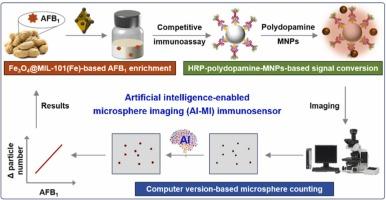基于磁性金属-有机框架的人工智能微球成像免疫传感器-辅助样品预处理检测花生黄曲霉毒素B1
IF 11.3
1区 环境科学与生态学
Q1 ENGINEERING, ENVIRONMENTAL
引用次数: 0
摘要
考虑到黄曲霉毒素B1 (AFB1)的强致癌性,敏感和快速检测对保障食品安全至关重要。本文开发了一种基于磁性金属有机框架辅助样品预处理的人工智能微球成像(AI-MI)免疫传感器,用于检测花生中的AFB1。在这项工作中,Fe3O4@MIL-101(Fe)作为磁性吸附剂有效地富集AFB1。基于竞争性免疫反应,富集的AFB1调节了辣根过氧化物酶(HRP)标记的山羊抗小鼠抗体偶联在聚苯乙烯(PS)免疫微球上的量。HRP可以用额外的过氧化氢催化PS微球表面快速形成聚多巴胺。由于具有丰富的官能团,聚多巴胺涂层可以吸附氨基功能化的磁性纳米颗粒形成PS探针。PS探针被磁分离,用光学显微镜观察,并使用计算机视觉算法计数。最后,PS探针数量的变化与AFB1的含量相关。优化条件下,Fe3O4@MIL-101(Fe)对AFB1的富集能力显著(1.59 mg/g), AI-MI免疫传感器对AFB1的灵敏度高(4.90 pg/mL,比酶联免疫吸附法提高19倍),线性范围宽(0.01 ~ 500 ng/mL)。这种AI-MI免疫传感器对微量毒素的智能检测具有重要的前景。本文章由计算机程序翻译,如有差异,请以英文原文为准。

Artificial intelligence-enabled microsphere imaging immunosensor based on magnetic metal-organic frameworks-assisted sample pretreatment for detecting aflatoxin B1 in peanuts
Sensitive and rapid detection of aflatoxin B1 (AFB1) is vital for safeguarding food safety, considering its potent carcinogenic toxicity. Herein, an artificial intelligence-enabled microsphere imaging (AI-MI) immunosensor based on magnetic metal-organic frameworks-assisted sample pretreatment was developed for detecting AFB1 in peanuts. In this work, Fe3O4@MIL-101(Fe) served as a magnetic adsorbent to efficiently enrich AFB1. Based on the competitive immunoreaction, the enriched AFB1 modulated the amount of horseradish peroxidase (HRP)-labeled goat anti-mouse antibody conjugated on the polystyrene (PS) immuno-microsphere. The HRP can catalyze the rapid formation of polydopamine on the surface of the PS microsphere with additional hydrogen peroxide. Due to the abundant functional groups, the polydopamine coating could adsorb amino-functionalized magnetic nanoparticles to form PS probes. The PS probes were magnetically separated, visualized with an optical microscope, and counted using a computer vision algorithm. Finally, the changes in the number of PS probes were correlated with the amount of AFB1. Under optimized conditions, Fe3O4@MIL-101(Fe) exhibited remarkable enrichment capacity (1.59 mg/g), and the AI-MI immunosensor showed a high sensitivity (4.90 pg/mL, 19-fold improvement over enzyme-linked immunosorbent assay) and a wide linear range (from 0.01 to 500 ng/mL) for AFB1. This AI-MI immunosensor holds significant promise for intelligent detection of trace toxins.
求助全文
通过发布文献求助,成功后即可免费获取论文全文。
去求助
来源期刊

Journal of Hazardous Materials
工程技术-工程:环境
CiteScore
25.40
自引率
5.90%
发文量
3059
审稿时长
58 days
期刊介绍:
The Journal of Hazardous Materials serves as a global platform for promoting cutting-edge research in the field of Environmental Science and Engineering. Our publication features a wide range of articles, including full-length research papers, review articles, and perspectives, with the aim of enhancing our understanding of the dangers and risks associated with various materials concerning public health and the environment. It is important to note that the term "environmental contaminants" refers specifically to substances that pose hazardous effects through contamination, while excluding those that do not have such impacts on the environment or human health. Moreover, we emphasize the distinction between wastes and hazardous materials in order to provide further clarity on the scope of the journal. We have a keen interest in exploring specific compounds and microbial agents that have adverse effects on the environment.
 求助内容:
求助内容: 应助结果提醒方式:
应助结果提醒方式:


